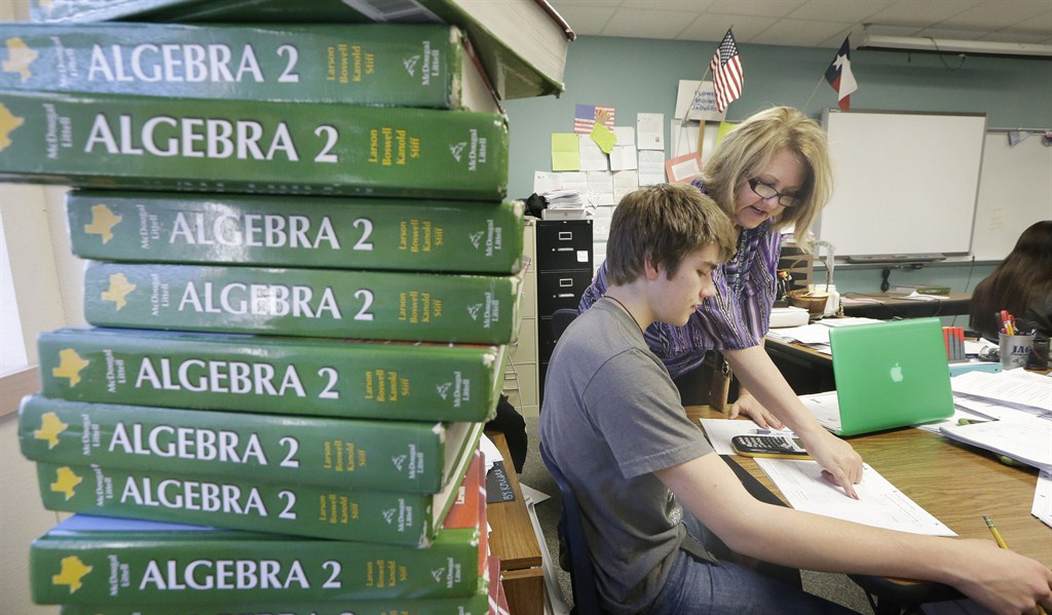Yesterday California adopted a set of new math standards which are focused less on math skills and more on equity and “meaning-making.”
The California State Board of Education voted to adopt a new—and much-debated—math framework on Wednesday, concluding a years-long process that involved three drafts, prompted hundreds of suggested revisions, and reignited decades-old arguments over the purpose of math education and the meaning of equity.
The 1,000-page framework aims to put meaning-making at the center of the math classroom, promoting a focus on problem-solving and applying math knowledge to real-world situations. It also encourages teachers to make math culturally relevant and accessible for all students, especially students of color who have been traditionally marginalized in the subject…
The framework is guidance, not a binding document, but it influences instructional practices, professional development, and materials adoption in California—one of the largest education markets in the country, with just under 6 million students in its K-12 public schools. Its reach has already been felt beyond the state’s borders.
In essence, the framework has become a proxy both for longstanding debates over math education—such as the teaching techniques teachers should use and whether to track students into different course sequences—and newer ones, such as if, and how, coursework should address social issues and politics.
The person driving this shift in math education is a Stanford professor named Jo Boaler. She has been criticized for her use of supporting evidence and also her behavior:
Last April, Jelani Nelson woke up to a jarring email from Jo Boaler, a Stanford University professor and the nation’s most prominent expert on math education. The two had never met. “As you know,” she began, “I am one of the authors of the proposed mathematics framework and I know you are working to oppose it.”
That “framework” is a policy document that will shape how math is taught in California and beyond, and Nelson, a computer-science professor at the University of California at Berkeley, had major problems with it — and with Boaler, too. He’d seen a series of tweets critical of her, and reposted one of them with his own scathing commentary. Now, Boaler was confronting him.
“I wanted to let you know,” she wrote, “that the sharing of private details about me on social media yesterday is now being taken up by police and lawyers.”
Later, Boaler apologized on Twitter for “leaving the impression” that she’d called the cops on Nelson, saying she was upset because her address had been posted elsewhere in the same Twitter thread. She’d just wanted to talk, she told me, “which is why I wrote him an email.” Nelson, who is Black, wasn’t buying it: “She wanted me to be scared. She wanted to intimidate me.”
Well, this is how social justice warriors usually operate so I’m not surprised. Speaking of social justice, that’s a big part of the new math standards. Back in 2021 when the first proposal was published I quote a bit of chapter 9 which was titled “Supporting Equitable and Engaging Mathematics Instruction.”
Equity cannot be an afterthought to more traditional mathematics content-centered offerings that do nothing to address the fact that “Black, Latinx, Indigenous, women, and poor students, have experienced long histories of underrepresentation in mathematics and mathematics-related domains” (Martin, 2019; see also Martin, Anderson, & Shah, 2017). Inequities caused by systemic issues means that a “culture of exclusion” persists even in equity-oriented teaching (Louie, 2017). Many of the stories that we use to define mathematics, and to talk about who does or is good at mathematics, are highly racialized and English language-centric, and are experienced that way by students (Lue & Turner, 2020). This means students’ mathematics identities are shaped in part by a culture of societal and institutionalized racism. Professional learning in mathematics can respond to these realities and aim for more than incremental change (which does little to change the framing narratives that drive inequities).
Notice all those citations? Clearly this is a rock-solid work of scholarship, right? Well, no, not really. A Stanford math professor decided to look up all the citations listed in the paper and found a lot of them simply didn’t hold up.
I read the entire CMF, as well as many of the papers cited within it. The CMF contains false or misleading descriptions of many citations from the literature in neuroscience, acceleration, detracking, assessments, and more. (I consulted with three experts in neuroscience about the papers in that field which seemed to be used in the CMF in a concerning way.) Sometimes the papers arrive at conclusions opposite those claimed in the CMF…
A sample misleading quote is “Park and Brannon (2013) found that when students worked with numbers and also saw the numbers as visual objects, brain communication was enhanced and student achievement increased.” This single sentence contains multiple wrong statements: (1) they worked with adults and not students; (2) their experiments involved no brain imaging, and so could not demonstrate brain communication; (3) the paper does not claim that participants saw numbers as visual objects: their focus was on training the approximate number system…
The CMF selectively cites research to make points it wants to make. For example, Siegler and Ramani (2008) is cited to claim that “after four 15-minute sessions of playing a game with a number line, differences in knowledge between students from low-income backgrounds and those from middle-income backgrounds were eliminated”. In fact, the study was specifically for pre-schoolers playing a numerical board game similar to Chutes and Ladders and focused on their numerical knowledge, and at least five subsequent studies by the same authors with more rigorous methods showed smaller positive effects of playing the game that did not eliminate the differences.
The Chronicle of Higher Education found similar problems when it looked at some of her published books. In this case she’s arguing about testing in math classes.
Another questionable claim relates to one of Boaler’s most despised class activities. “For about one third of students the onset of timed testing is the beginning of math anxiety,” she asserts in Mathematical Mindsets and a Youcubed white paper, adding that the tests are “a major cause of this debilitating, often life-long condition.”
But the basis for that causal link is a mystery, Greg Ashman, a math teacher and school administrator in Victoria, Australia, has found. Mathematical Mindsets cites the white paper, which in turn cites a 2014 opinion piece in a journal for math educators, but nowhere within it is a reference to sufficiently back up the claim. Boaler did not identify any such citation when asked, but instead provided me with a list of studies that were not in the article. She also said that “one third” was an estimate that “comes from 30 years of looking at different studies and examples.”
Ashman said he worried that Boaler was calling timed tests harmful without evidence, when research indicates that repeatedly practicing rapid calculations can help students build fluency with math and improve their math skills. Having blogged about several apparent inconsistencies in her work, Ashman, who has a Ph.D. in instructional design, told me, “She is sometimes careless with the evidence.” In return, Boaler accused him of criticizing her because he is “selling” opposing ideas, such as books about teacher-led instruction. “Of course he doesn’t like me sharing that timed tests in elementary school cause math anxiety,” she said.
In 2019, when Boaler tweeted that “timed tests are the cause of math anxiety,” Ashman responded, “I disagree — you have not demonstrated a causal link,” and pointed to the blog post he’d written. She did not respond and, later, blocked him.
This doesn’t sound like someone whose work should be the basis for an entire state’s math curriculum. But the fact that she is focused on social justice seems to carry a lot of weight. The earlier draft also linked to this document which was even more explicit. Here’s a bit of the text on centering “ethnomathematics.”
• Recognize the ways that communities of color engage in mathematics and problem solving in their everyday lives.
• Teach that mathematics can help solve problems affecting students’ communities. Model the use of math as a
solution to their immediate problems, needs, or desires.
• Identify and challenge the ways that math is used to uphold capitalist, imperialist, and racist views.
• Teach the value of math as both an abstract concept and as a useful everyday tool.
• Expose students to examples of people who have used math as resistance. Provide learning opportunities that use math as resistance.
This doesn’t sound like math to me at all but I guess that’s the point. Math class can also be social justice class with the right textbooks.
Another big topic covered by the new framework is math de-tracking. Basically this boils down to pushing all students to take Algebra in 9th grade instead of 8th grade which makes it harder for advanced students to get through Calculus in high school. There’s quite a backstory on this topic as well. De-tracking was adopted in San Francisco explicitly for social justice goals, i.e. improving the achievement gap between white and minority students. The state then decided to adopt the idea as part of the new math framework. But as I pointed out here, there’s evidence that San Francisco’s de-tracking policy didn’t work. In fact, it seems to have backfired. Scores among black students post de-tracking improved very slightly but scores among Hispanic students dropped.
More recently, a group of Stanford academics looked at the San Francisco de-tracking results and found them lacking:
A much-debated change to math course sequencing in the San Francisco schools designed to reduce racial inequities has increased Black students’ access to some higher-level courses.
But racial inequities at the most advanced levels of high school math remain largely unchanged, according to a new analysis released March 20…
“It was really the sense that outside commentators and the district weren’t fundamentally agreeing about what actually happened that motivated [this study],” said Thomas Dee, a professor at Stanford University’s Graduate School of Education and one of the paper’s authors…
“Closing those racial and ethnic gaps in advanced math coursetaking was a central stated goal of this reform. And it seems pretty clear that in that regard, it failed on its own terms,” Dee said.
The evidence is so clear that San Francisco’s school superintendent told the SF Chronicle it was possible they could reverse course. I don’t believe that has happened and now the same idea has been adopted statewide despite the fact that it doesn’t work. So long as you promise more equity it seems the actual results don’t matter that much.
My guess is that this new plan will similarly fail, test scores will drop but it will be proclaimed a success anyway because equity. Eventually, maybe years from now some of this will get rolled back.








Join the conversation as a VIP Member